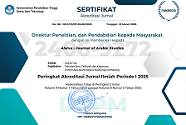Language Disorders in Autistic Students in Learning Arabic at Elementary School of Anak Shaleh Malang
DOI:
https://doi.org/10.21580/alsina.4.2.12287Keywords:
Autistic students, language disorders, learning ArabicAbstract
This article aims to describe the types of autistic and language disorders experienced by autistic students, problems of learning arabic faced by autistic students and the teacher's efforts in overcoming problems caused by language disorders when learning Arabic. This article uses a descriptive qualitative approach. data collection through interviews, observation, documentation. Data collected were analyzed through the steps of data reduction, data presentation, drawing conclusions. The findings of this article are: (1) the types of autism and language disorders experienced were: Suffering from attention deficit hyperactivity disorder and autism with active group classification but rarely or called mild autism. Experiencing Autism with the type of Asperger's syndrome. Experiencing severe autism, the characteristics that appear in this student are having trouble communicating, he likes to be quiet with his own activities. (2) The problems in language disorders are: hard to get along and slow in receiving lesson information and Weak Academic Skills, Communication and Behavior. (3) the teacher’s endeavor to solve these problems, they are Take a different special approach, including by frequently communicating lightly. Collaborate between teachers. Provide full opportunities for GPK to assist and carry out therapy, both at home and at school.Downloads
References
Adriana S. Ginanjar. Menjadi Orang Tua Istimewa: Panduan Praktis Mendidik Anak Autis. Jakarta: Dian Rakyat, 2008.
Al-Zuraiqāt, Ibrāhīm ʿAbd Allāh. Iḍṭirābāt al-Kalām wa-al-Lughah: al-Tashkhīsh wa-al-ʿIlāj. Amman: Dār al-Fikr, 2005.
Aljameel, Sumayh, James O’Shea, Keeley Crockett, Annabel Latham, and Mohammad Kaleem. “LANA-I: An Arabic Conversational Intelligent Tutoring System for Children with ASD.” In Intelligent Computing. CompCom 2019. Advances in Intelligent Systems and Computing, edited by Kohei Arai, Rahul Bhatia, and Supriya Kapoor, 997:498–516. Cham: Springer International Publishing, 2019.
Altakhaineh, Abdel Rahman Mitib, Hodan Mahmoud, and Alaa Y. Abukhater. “The Effectiveness of Using Colors in L1 and L2 Vocabulary Development of Autistic Children.” Advances in Autism 6, no. 3 (2020): 215–26. https://doi.org/10.1108/AIA-10-2019-0032.
Azmi, Nur Izzah Sarihah, and Zarima Mohd Zakaria. “Teaching and Learning Arabic for Autistic Students.” International Journal of Modern Education 2, no. 6 (2020): 1–7. https://doi.org/10.35631/IJMOE.26001.
Berk, Laura E. Child Development. 9th ed. Boston: Pearson Education, 2013.
Chaer, Abdul. Psikolinguistik: Kajian Teoretik. Jakarta: Rineka Cipta, 2009.
Dawodi, Aysha Faraj AL, Sarah Faisal Alzahrani, Reema Abdulkareem Almumtin, Sarah Saeed Alshyban, Muneerah Alshabanah, Daniah Alrajhi, Mutasem K. Alsmadi, and Ibrahim Almarashdeh. “Developing and Implementing an Online Learning Platform for Children with Autism.” International Journal of Scientific Research in Science and Technology 7, no. 2 (2020): 176–88. https://doi.org/10.32628/IJSRST207162.
Dillon, Emily, Calliope Holingue, Dana Herman, and Rebecca J. Landa. “Psychometrics of the Pragmatic Rating Scale for School-Age Children With a Range of Linguistic and Social Communication Skills.” Journal of Speech, Language, and Hearing Research 64, no. 9 (September 14, 2021): 3477–88. https://doi.org/10.1044/2021_JSLHR-20-00753.
Fasolo, Mirco, Laura D’odorico, Alessandro Costantini, and Rosalinda Cassibba. “The Influence of Biological, Social, and Developmental Factors on Language Acquisition in Pre-Term Born Children.” International Journal of Speech-Language Pathology 12, no. 6 (2010): 461–71. https://doi.org/10.3109/17549507.2011.486445.
Ferawati, Ferawati. “Gangguan Berbahasa Arab bagi Anak Autis dan Al-Qur`An sebagai Terapi Pengobatan.” An Nabighoh Jurnal Pendidikan dan Pembelajaran Bahasa Arab 19, no. 2 (2017): 213–24. https://doi.org/10.32332/an-nabighoh.v19i2.1000.
Hadis, Abdul. Pendidikan Anak Berkebutuhan Khusus Autistik. Bandung: Alfabeta, 2006.
Heyman, Michelle, Megan Ledoux Galligan, Giselle Berenice Salinas, Elizabeth Baker, Jan Blacher, and Katherine Stavropoulos. “Differential Diagnosis of Autism Spectrum Disorder, Intellectual Disability and Attention-Deficit Hyperactivity Disorder (ADHD).” Advances in Autism 8, no. 2 (February 16, 2022): 89–103. https://doi.org/10.1108/AIA-01-2021-0002.
Indah, Rohmani Nur, and Abdurrahman. Psikolinguistik: Konsep & Isu Umum. Malang: UIN Malang Press, 2008.
Kissine, Mikhail, Xavier Luffin, Fethia Aiad, Rym Bourourou, Gaétane Deliens, and Naoufel Gaddour. “Noncolloquial Arabic in Tunisian Children With Autism Spectrum Disorder: A Possible Instance of Language Acquisition in a Noninteractive Context.” Language Learning 69, no. 1 (March 2019): 44–70. https://doi.org/10.1111/lang.12312.
Manṣūr, ʿAbd al-Majīd Sayyid Aḥmad. ʿIlm al-Lughah al-Nafsī. Riyadh: Jāmiʿat al-Malik Suʿūd, 1982.
Munawwir, Ahcmad Warson, and Muhammad Fairuz. Kamus Al-Munawwir Indonesia-Arab Terlengkap. Surabaya: Pustaka Progressif, 2007.
Patton, Michael Quinn. Qualitative Research & Evaluation Methods: Integrating Theory and Practice. 4th ed. Thousand Oaks: SAGE Publications, Inc., 2014.
Pujaningsih, Pujaningsih. “Perkembangan Bahasa dan Gangguan Bahasa pada Anak Berkebutuhan Khusus.” JPK (Jurnal Pendidikan Khusus) 6, no. 2 (2010): 42–53. https://doi.org/10.21831/jpk.v6i2.6735.
Tiel, Julia Maria van. “Gifted Terlambat Bicara VS Autisme dan atau ADHD/ADD Bagaimana Pendidikannya?” In Seminar dan Workshop Program Inklusi. Semarang, 2010.
Zhran, Ayman Ramadan Soliman, Turki Fahed Almasaeid, and Mostafa Mohamed Abo Elnour. “Implementing of Kinematic Synergy Strategies to Develop Basic Language Skills for A Sample of Special Needs Students.” International Journal of Psychosocial Rehabilitation 24, no. 4 (2020): 3533–43. https://doi.org/10.37200/IJPR/V24I4/PR201465.
ʿAlī, Dilshād, and Suhād Al-Millī. “Fāʿilīyat Barnāmij Tadrībī li-Tanmiyat al-Sulūkīyāt ghayr al-Lafẓīyah ladá ʿAynah min al-Aṭfāl al-Tawaḥḥudīyīn: Dirāsat Shibh Tajrībīyah fī al-Munaẓẓamah al-Sūrīyah lil-Muʿawwiqīn.” Majallat Jāmiʿat Dimashq lil-ʿUlūm al-Tarbawīyah wa-al-Nafsīyah 29, no. 1 (2013): 193–234. https://search.mandumah.com/Record/487893.
Downloads
Published
How to Cite
Issue
Section
License
Copyright
The copyright of the received article shall be assigned to the publisher of the journal. The intended copyright includes the right to publish the article in various forms (including reprints). The journal maintains the publishing rights to published articles. Authors are allowed to use their articles for any legal purposes deemed necessary without written permission from the journal, but with an acknowledgment to this journal of initial publication.
Licensing
In order for Alsina: Journal of Arabic Studies to publish and distribute research articles, the editors need publishing rights (transferred from author to publisher). This agreement relates to the transfer/publishing copyright license to Alsina: Journal of Arabic Studies but the authors still have significant rights to use and share their published articles.
Alsina: Journal of Arabic Studies supports the need for writers to share, disseminate and maximize the impact of their research and their rights on any database. As a journal article writer, you have the right to various uses of your articles, including that by the institution or company where you work. Copyright can be used without the need for special permission. Authors who publish articles in the Alsina: Journal of Arabic Studies have broad rights to use their work for teaching and scientific purposes without requesting permission, including:
- Use by the author for lectures, presentations, or conferences, with distribution of copies to participants;
- Distribution to colleagues for research use;
- Use in compilations of the author's subsequent work;
- inclusion in a thesis or dissertation;
- Reuse of sections or excerpts from articles in other works (with full acknowledgment of the final article);
- Preparation of derivative works (other than commercial purposes) (with full acknowledgment of the final article);
- Voluntary posting on open websites operated by authors’ or writers' agencies for scientific purposes
When submitting a manuscript, authors do so on the understanding that if accepted for publication, the copyright for publishing (publishing right) of the article shall be assigned/transferred to Alsina: Journal of Arabic Studies.
Authors whose articles are accepted for publication will receive confirmation via email and sent a Copyright Transfer Agreement.


 Accreditation
Accreditation 
 In Collaboration with
In Collaboration with 

 Visitors
Visitors  Article Template
Article Template





